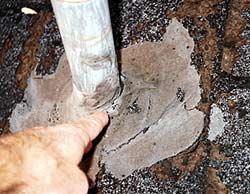Asphalt Shingle Roofs
Problem:
No drip edge.
If asphalt shingles are installed without a drip edge, it’s only a matter of time before the plywood sheathing and fascia begin to rot. Water dripping off the edges of the roofing is drawn by capillary action to the exposed edges of the plywood sheathing.
Solution:
Install a metal drip edge at rakes and eaves.
The main purpose of a metal drip edge is to interrupt the wicking of water to the sheathing edges.
Problem:
Felt underlayment incorrectly lapped under (instead of over) the metal drip edge. Any water that may get under the shingles – for instance, from wind-driven rain – should be carried by the felt underlayment over the top of the drip edge.
Solution:
Lap the felt underlayment over the drip edge.
Problem: Valley shingles were not tabbed or spotted with roofing cement. The large volume of water that collects in a valley can back up under uncemented shingles. Solution: In a closed valley, embed valley shingles in roofing cement. Always clip the top corner of the valley shingles at a 45-degree angle. This prevents debris from getting caught in the shingles and accumulating in the valley, and it also directs water toward the valley centerline. For extra protection, install a self-adhering eaves membrane under valleys.
